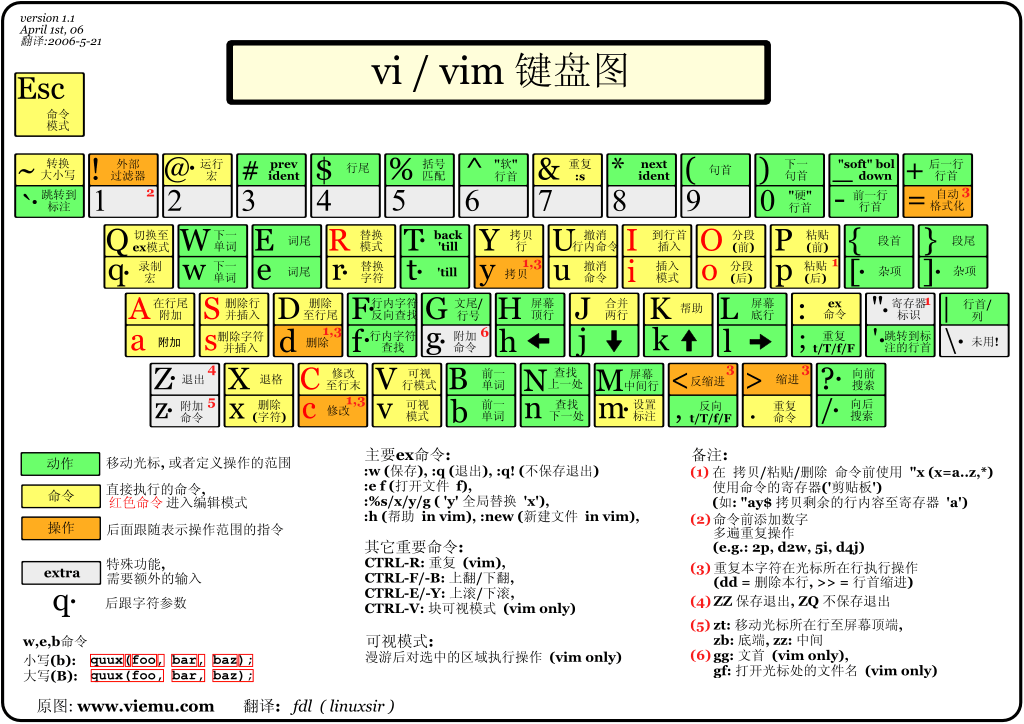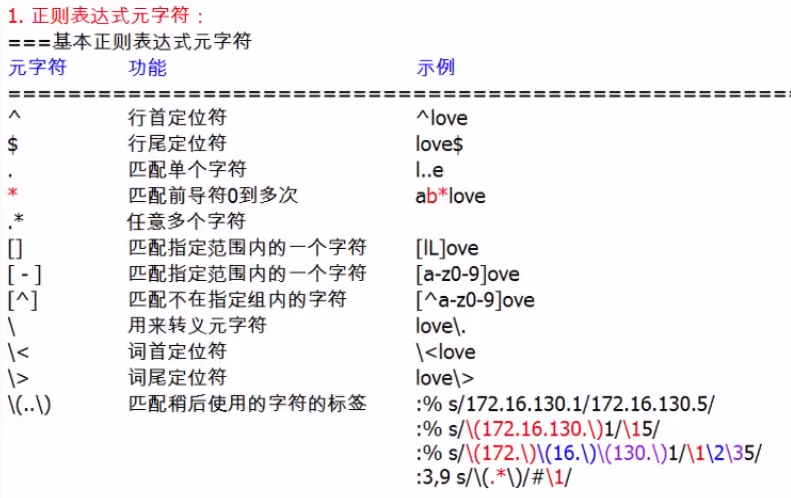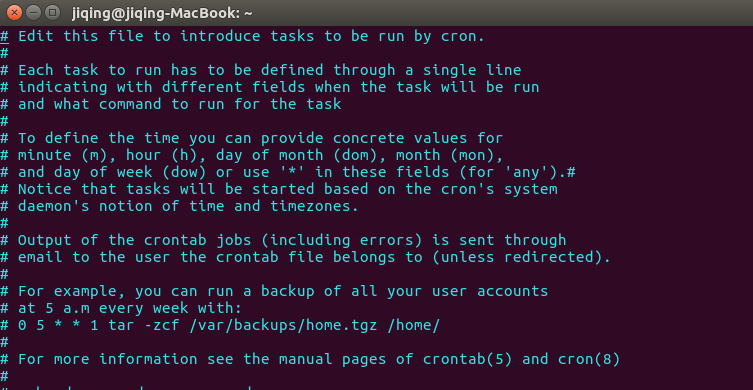我在
vim:
foo barba[r]bar foo
[]表示光标位置
当我使用vaw或viw时,barbarbar是高位的.没关系.
但我想明白 – 为什么? v是视觉模式,a – 我不知道为什么,并且正常接近新词的开头.
我也检查了caw和ciw.第一个删除barbarbar并在foo之后留下光标没有空格,第二个会在foo之后留下空格,两个都进入插入模式…
那为什么它有效呢?在vim帮助中是否有任何反对意见?任何人都可以翻译为vim语言吗?
请参阅:help text-object.这解释了这一切比这里任何人都好.
这是整个部分:
6. Text object selection *object-select* *text-objects*
*v_a* *v_i*
This is a series of commands that can only be used while in Visual mode or
after an operator. The commands that start with "a" select "a"n object
including white space,the commands starting with "i" select an "inner" object
without white space,or just the white space. Thus the "inner" commands
always select less text than the "a" commands.
These commands are {not in Vi}.
These commands are not available when the |+textobjects| feature has been
disabled at compile time.
*v_aw* *aw*
aw "a word",select [count] words (see |word|).
Leading or trailing white space is included,but not
counted.
When used in Visual linewise mode "aw" switches to
Visual characterwise mode.
*v_iw* *iw*
iw "inner word",select [count] words (see |word|).
White space between words is counted too.
When used in Visual linewise mode "iw" switches to
Visual characterwise mode.
*v_aW* *aW*
aW "a WORD",select [count] WORDs (see |WORD|).
Leading or trailing white space is included,but not
counted.
When used in Visual linewise mode "aW" switches to
Visual characterwise mode.
*v_iW* *iW*
iW "inner WORD",select [count] WORDs (see |WORD|).
White space between words is counted too.
When used in Visual linewise mode "iW" switches to
Visual characterwise mode.
*v_as* *as*
as "a sentence",select [count] sentences (see
|sentence|).
When used in Visual mode it is made characterwise.
*v_is* *is*
is "inner sentence",select [count] sentences (see
|sentence|).
When used in Visual mode it is made characterwise.
*v_ap* *ap*
ap "a paragraph",select [count] paragraphs (see
|paragraph|).
Exception: a blank line (only containing white space)
is also a paragraph boundary.
When used in Visual mode it is made linewise.
*v_ip* *ip*
ip "inner paragraph",select [count] paragraphs (see
|paragraph|).
Exception: a blank line (only containing white space)
is also a paragraph boundary.
When used in Visual mode it is made linewise.
a] *v_a]* *v_a[* *a]* *a[*
a[ "a [] block",select [count] '[' ']' blocks. This
goes backwards to the [count] unclosed '[',and finds
the matching ']'. The enclosed text is selected,including the '[' and ']'.
When used in Visual mode it is made characterwise.
i] *v_i]* *v_i[* *i]* *i[*
i[ "inner [] block",excluding the '[' and ']'.
When used in Visual mode it is made characterwise.
a) *v_a)* *a)* *a(*
a( *v_ab* *v_a(* *ab*
ab "a block",select [count] blocks,from "[count] [(" to
the matching ')',including the '(' and ')' (see
|[(|). Does not include white space outside of the
parenthesis.
When used in Visual mode it is made characterwise.
i) *v_i)* *i)* *i(*
i( *v_ib* *v_i(* *ib*
ib "inner block",from "[count] [("
to the matching ')',excluding the '(' and ')' (see
|[(|).
When used in Visual mode it is made characterwise.
a> *v_a>* *v_a<* *a>* *a<*
a< "a <> block",select [count] <> blocks,from the
[count]'th unmatched '<' backwards to the matching
'>',including the '<' and '>'.
When used in Visual mode it is made characterwise.
i> *v_i>* *v_i<* *i>* *i<*
i< "inner <> block",from
the [count]'th unmatched '<' backwards to the matching
'>',excluding the '<' and '>'.
When used in Visual mode it is made characterwise.
*v_at* *at*
at "a tag block",select [count] tag blocks,from the
[count]'th unmatched "<aaa>" backwards to the matching
"</aaa>",including the "<aaa>" and "</aaa>".
See |tag-blocks| about the details.
When used in Visual mode it is made characterwise.
*v_it* *it*
it "inner tag block",excluding the "<aaa>" and "</aaa>".
See |tag-blocks| about the details.
When used in Visual mode it is made characterwise.
a} *v_a}* *a}* *a{*
a{ *v_aB* *v_a{* *aB*
aB "a Block",select [count] Blocks,from "[count] [{" to
the matching '}',including the '{' and '}' (see
|[{|).
When used in Visual mode it is made characterwise.
i} *v_i}* *i}* *i{*
i{ *v_iB* *v_i{* *iB*
iB "inner Block",from "[count] [{"
to the matching '}',excluding the '{' and '}' (see
|[{|).
When used in Visual mode it is made characterwise.
a" *v_aquote* *aquote*
a' *v_a'* *a'*
a` *v_a`* *a`*
"a quoted string". Selects the text from the previous
quote until the next quote. The 'quoteescape' option
is used to skip escaped quotes.
Only works within one line.
When the cursor starts on a quote,Vim will figure out
which quote pairs form a string by searching from the
start of the line.
Any trailing white space is included,unless there is
none,then leading white space is included.
When used in Visual mode it is made characterwise.
Repeating this object in Visual mode another string is
included. A count is currently not used.
i" *v_iquote* *iquote*
i' *v_i'* *i'*
i` *v_i`* *i`*
Like a",a' and a`,but exclude the quotes and
repeating won't extend the Visual selection.
Special case: With a count of 2 the quotes are
included,but no extra white space as with a"/a'/a`.
When used after an operator:
For non-block objects:
For the "a" commands: The operator applies to the object and the white
space after the object. If there is no white space after the object
or when the cursor was in the white space before the object,the white
space before the object is included.
For the "inner" commands: If the cursor was on the object,the
operator applies to the object. If the cursor was on white space,the
operator applies to the white space.
For a block object:
The operator applies to the block where the cursor is in,or the block
on which the cursor is on one of the braces. For the "inner" commands
the surrounding braces are excluded. For the "a" commands,the braces
are included.
When used in Visual mode:
When start and end of the Visual area are the same (just after typing "v"):
One object is selected,the same as for using an operator.
When start and end of the Visual area are not the same:
For non-block objects the area is extended by one object or the white
space up to the next object,or both for the "a" objects. The
direction in which this happens depends on which side of the Visual
area the cursor is. For the block objects the block is extended one
level outwards.
For illustration,here is a list of delete commands,grouped from small to big
objects. Note that for a single character and a whole line the existing vi
movement commands are used.
"dl" delete character (alias: "x") |dl|
"diw" delete inner word *diw*
"daw" delete a word *daw*
"diW" delete inner WORD (see |WORD|) *diW*
"daW" delete a WORD (see |WORD|) *daW*
"dd" delete one line |dd|
"dis" delete inner sentence *dis*
"das" delete a sentence *das*
"dib" delete inner '(' ')' block *dib*
"dab" delete a '(' ')' block *dab*
"dip" delete inner paragraph *dip*
"dap" delete a paragraph *dap*
"diB" delete inner '{' '}' block *diB*
"daB" delete a '{' '}' block *daB*
Note the difference between using a movement command and an object. The
movement command operates from here (cursor position) to where the movement
takes us. When using an object the whole object is operated upon,no matter
where on the object the cursor is. For example,compare "dw" and "daw": "dw"
deletes from the cursor position to the start of the next word,"daw" deletes
the word under the cursor and the space after or before it.
请注意,您可以使用两个命令创建自己的文本对象(例如,您希望“K”成为新的文本对象:在运算符模式下,您希望选择三个字符,光标位于中心,在视觉模式下,您可以喜欢将选择延伸1个字符到两端(假设您的光标位于选择的末尾):
"operator-pending mapping onoremap K :normal! hv2l<return> "visual mapping (xmap preferred over vmap because vmap also works in select mode) "note that in visual mode o goes to the other end. Therefore this will expand selection if you were at the end and restrict it otherwise. xnoremap K ohol





